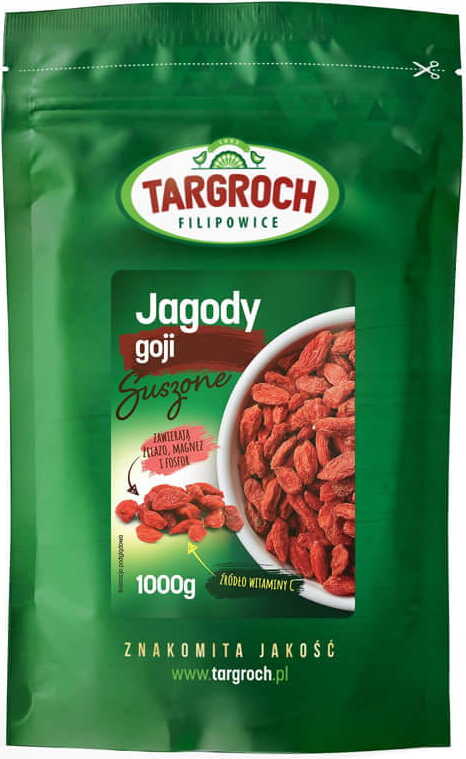Dried goji berries 1000g TARGROCH
- Regular price
- €16,01
- Regular price
-
- Sale price
- €16,01
- Unit price
- per
Description
xDESCRIPTION
-high dose of antioxidants
-contains carotenoids
-contains zinc, iron, calcium, copper, selenium, phosphorus
-this is a good source of B vitamins, vitamin C and E
-positively influences the visual organ
The wolfberry bush is a plant that produces goji berries. Native to central China, it is now more popular and cultivated in many regions of the world, such as Tibet and Mongolia. In China, these berries have been used for thousands of years. These berries are small, red fruits, about 2 cm in size. They can be eaten raw but are most often dried. They are also used to make wine, teas, and liqueurs. They have a quite tart flavor, and 100g contains 370 kcal. They are suitable as a standalone snack or as an addition to sweet and savory dishes. Raw fruits can be boiled in water before consumption or added to soups, rice, and sauces.
Goji berries contain carotenoids, which give them their color and have a positive effect on the skin. They also contain polysaccharides, essential oils, and fatty acids such as hexadecanoic acid, linoleic acid, and myristic acid. They also contain organic acids such as malic acid, citric acid, shikimic acid, and fumaric acid. They can enrich our diet with minerals such as zinc, iron, calcium, copper, selenium, and phosphorus. They contain B vitamins, vitamins C, and E. Thanks to the presence of polysaccharides and polyphenols, they have antioxidant properties, meaning they fight free radicals in our body. These tiny fruits are a treasure trove of nutritional benefits that have a positive effect on the skin, rejuvenating it and supporting our immunity.
Also worth mentioning is their positive effect on vision. This is due to their carotenoid content, particularly zeaxanthin, which makes up the majority of the carotenoids, and lutein. Together, these protect the retina of the eye from damage caused by free radicals. Lutein protects our eyes from the harmful effects of light and UV radiation by absorbing visible blue light.
INTERESTING
According to a Chinese legend, the person who regularly consumed goji berries and led to their popularization lived up to 252 years.
These fruits should not be eaten when unripe. This can cause digestive problems.
INGREDIENTS
Goji berries.
APPLICATION
Goji berries can be eaten dried. They are perfect as an addition to desserts, yogurts, muesli, vegetable dishes, and soups.
| Nutritional value of the product | in 100 g |
| Calorific value | 1657/396 kcal |
| Fat | 4.2g |
| - including saturated fatty acids | 0.8 g |
| Carbohydrates | 22.3 g |
| -w including sugar | 11.1 g |
| Fiber | 6.2 g |
| protein | 10.6 g |
| Salt | 0.06 g |
ALLERGEN INFORMATION
The facility also packages sesame, almonds, products containing sulfur dioxide (SO2), gluten-containing products, and various nuts. Despite all efforts, these raw materials cannot be completely eliminated.
STORAGE
Store in a dry, tightly closed container.
similar products
- Regular price
- €16,01
- Regular price
-
- Sale price
- €16,01
- Unit price
- per
- Regular price
- €16,01
- Regular price
-
- Sale price
- €16,01
- Unit price
- per
- Regular price
- €16,01
- Regular price
-
- Sale price
- €16,01
- Unit price
- per
- Regular price
- €16,01
- Regular price
-
- Sale price
- €16,01
- Unit price
- per
- Regular price
- €16,01
- Regular price
-
- Sale price
- €16,01
- Unit price
- per
- Regular price
- €16,01
- Regular price
-
- Sale price
- €16,01
- Unit price
- per
- Regular price
- €16,01
- Regular price
-
- Sale price
- €16,01
- Unit price
- per
- Regular price
- €16,01
- Regular price
-
- Sale price
- €16,01
- Unit price
- per
- Regular price
- €16,01
- Regular price
-
- Sale price
- €16,01
- Unit price
- per
- Regular price
- €16,01
- Regular price
-
- Sale price
- €16,01
- Unit price
- per
Recently Viewed Products
- Choosing a selection results in a full page refresh.












